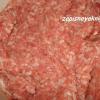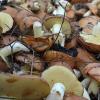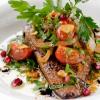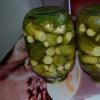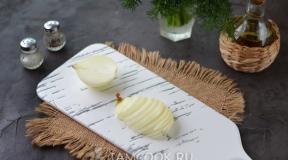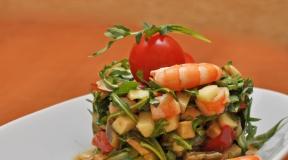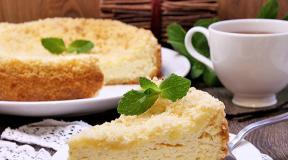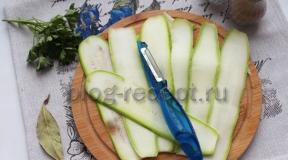Dried berries in the oven. Variations on dried berries
fresh berries and fruits contain up to 90% water, so they quickly wither, rot and deteriorate. If you reduce the water content in them to 18 percent, then they become resistant to microorganisms, stop spoiling, and can be stored for a long time. As studies show, dried fruits and the berries keep all their beneficial features. That is why people do not stop from year to year to dry berries and fruits at home. And how exactly, I will consider in my article.
Apples.
Consider first how to dry at home. Best suited for drying intolerant sweet and sour fruits that do not have watery flesh, light yellow and white color. These can be varieties "Cinnamon", "Antonovka ordinary", "Pepin saffron", "Papirovka" and others). Sweet apples are not suitable for drying, as they are tasteless when dried, and besides, they do not boil well afterwards.
Before drying, all apples should first be sorted by size, then washed, discarded, removed the core and rot. small apples cut into halves, quarters or left whole, but large and medium - in without fail cut into slices 5 cm thick or slices.
Before drying, you can remove the peel from the apples. To prevent browning, slices and pieces must be kept for three minutes in an aqueous solution. table salt(100 grams of salt per 10 liters of water), and then dry in the sun. Dry the apples in the oven, oven, dryer.
At the same time, they need to be dried from 4 to 6 hours at 80 ° C. When 2/3 of the moisture has evaporated from the apples, the temperature is reduced to 50 ° C, in order to avoid burning the slices. Ready dried fruits are cooled on baking sheets.
Plums.
Before drying at home, its fruits must be blanched for 30 seconds in a boiling soda solution (100 grams of baking soda per 10 liters of water), and then dipped in cold water. Next, you should dry the plum in the oven for up to two days, at 45 ° C, and after 3 - 4 hours (after drying) - turn up the heat to 60 ° C, and then to 75 - 80 ° C.
In order for the plum to become dark and shiny, it must be held for several minutes at a temperature of more than 100 ° C until drying is completed. In this case, the sugar from the pulp will come to the surface and caramelize.
Berries.
Berries are best dried in a mixed way: first in the sun, and then dried in the oven. To dry for the winter, it must first be selected. After all, only dry, unripe raspberries are suitable for drying, while mature ones become sour. Sorted raspberries immediately after harvesting are laid out in a thin layer for drying in the sun. Then you need to dry the raspberries in the oven on a baking sheet for several hours in a non-hot oven. After drying, the blackened berries are discarded.
Before drying, small berries from dark-colored varieties should first be sorted out, washed, and folded into a 3 cm layer on a baking sheet. Gooseberries should be dried in the sun until dried, then they are dried in the oven, gradually raising the temperature from 45 to 60 degrees Celsius.
In order to prevent the fruits from steaming, it is better to keep the oven door ajar at first and close gradually during drying. Properly dried fruits (after 2-3 hours) do not secrete juice and do not stain hands.
How to dry berries currants?
How to dry berries?
How to dry fruits?
How to dry fruits strawberries?
Yes, in fact, just like drying berries in the oven, in the way described above. The only exception is . Her berries must be dried immediately in the oven.
How to dry rose hips.
To do this, they are harvested in late autumn, selecting large hard berries Red. Dry them in the shade outdoors or in a dry, warm, ventilated area, turning occasionally. Artificial drying is not desirable for them. For drying, it is better to cut the berries in half, remove the seeds and hairs. In this case, the shells of the berries or the berries themselves are laid out in one layer on paper or cloth.
How to dry hawthorn fruits.
With therapeutic purpose dried fruits of prickly hawthorn and. The fruits are stored at maturity and until frost. Berries are dried in the sun or at 60°C in dryers. For this, 1 sq. m. scatter up to 5 kg of fruit and mix occasionally. Properly dried berries may have a whitish coating.
How to dry mulberries at home.
To do this, the berries are laid out in the sun on a fine grid. Every day, after sunset, the berries are brought into a dry room with ventilation and covered with a film. The next day, and so for 2 weeks, again dried in the sun.
To speed up their drying, they are dried for two days in the sun, as described above, and then dried in the oven at 25 degrees. Dried berries are stored in hermetically sealed glass jars.
Carolina, www.site
Google
- Dear our readers! Please highlight the found typo and press Ctrl+Enter. Let us know what's wrong.
- Please leave your comment below! We ask you! We need to know your opinion! Thank you! Thank you!
In order to dry the berries, raspberries, cherries and blackberries begin to be harvested in August and do so as they ripen. An indispensable condition for collecting berries for drying is the average ripeness of the berries, in addition, the berries must be dry and dense.
Ripe and overripe berries are not suitable for drying at home, due to their high moisture content.
Collection of berries and fruits - preparation for drying.
Exactly the same conditions apply to the collection of fruits, plums and apricots. Apples are usually harvested for drying at home in August - September. Optimal time days for picking fruits and berries - not early sunny morning - the period when the dew that fell at night has already dried up. You should not wait until all the berries are ripe. It will be better to collect them gradually as they ripen, because if the berries are very ripe and loose, they will release a lot of juice and it will be problematic to dry them well.
Collect berries for drying at home should be together with the stalks. This applies to raspberries and blackberries. Cuttings of cherries, plums, apricots and apples can be cut off immediately. Then harvested berries and fruits need to be prepared for the process further drying- sort and sort, put aside crumpled overripe berries. Then, from the berries selected for drying, remove the stalks and spread in one layer on a baking sheet.

Cut the apples thinly into pieces. Remove pits from plums and apricots. Small fruits can be dried directly with seeds. Since it is not recommended to wash berries and fruits before drying them, it is important that fruit trees and berry bushes were not treated with pesticides and were not fertilized for a month before picking.
Drying berries and fruits at home.
Berries and fruits are dried at home, usually in three main ways. You can dry it in the oven, in the open air, in a specialized electric household or semi-professional dryer.

1. In order to dry berries and fruits in the open air, trays and trays with them must be placed in the shade, in a well-ventilated place. It can be a canopy or a gazebo. The main thing is that the weather for several days should not be rainy, and the daytime temperature should exceed 25 degrees Celsius. So open way fruits and berries will dry for about five days, in addition, you will often have to turn them over so that they do not rot on one side and dry evenly and completely.
2. For drying berries and fruits at home in conventional oven, they are laid out in one layer on a standard baking sheet and placed in an oven preheated to a temperature of 60-70 degrees. It is necessary to dry fruits and berries at this temperature regime for about 3-4 hours, then mix and reduce the temperature to 40 degrees. It usually takes another couple of hours to bring dried fruits and berries to fully prepared. This is the most affordable way drying for home conditions, but it has a significant drawback - high temperature regime degrades the quality of the dried product.
3. Specialized dryers for home use provide the highest quality, fastest and most reliable results. In household dryers, berries need to be laid out in special nets in one layer, leaving a space regulated by the drying manufacturer between the rows of nets. Drying berries and fruits, depending on the power and features of drying, will take more than 10 hours. Unlike drying in the oven, dried berries and fruits retain their beneficial properties to the maximum. This is also true for outdoor drying, but the drying time is significantly reduced. But when drying in the oven due to exposure to high temperatures, the quality dried berries and fruit gets lower.
Slimming with . Calculation of the glycemic index in the tables of Montignac.
Fruits and berries contain about 85-90% water. To preserve them, it is necessary to remove water so that the dried fruit contains no more than 15-20% of it.
The two most common drying methods are natural (solar-air) and artificial (thermal). Fruit is dried in the sun mainly in areas with dry, hot summers. This method is time consuming, although simple. Artificial drying is more convenient and reliable, since fruits are dried in ovens, ovens or special dryers. The rapid evaporation of water in this case depends on the total surface of the fruit, the speed of air circulation and the difference between the vapor pressure on the fruit surface and the water vapor pressure in the air stream. The rate of drying also depends on the rate of entry of intracellular water. That is why the fruits are cut into thin slices to reduce the drying time.
Drying should not be excessive, as there is a risk of impairing the taste of the finished product and the ability of dried fruit to restore its original volume, for example, when preparing compotes.
At home, you can dry fruits and berries that do not lose juice during prolonged drying - apples, pears, black currants. Cherries and plums are less suitable for drying. Quite mature and strong fruits and berries are dried. To speed up drying and prevent browning, fruits and berries should be blanched for 2-3 minutes in boiling water. Cherries, cherries and plums are only scalded with boiling water.
How to choose the right drying temperature
In the initial period of drying, too high a temperature is undesirable, since overdrying of the outer layers of the product is possible, the formation of a crust, which will prevent the continuous evaporation of water and slow down drying. Therefore, it begins at a moderate temperature, gradually increasing to 60-80 ° C. Of particular importance is right choice temperature during the final drying period, when the moisture evaporates very slowly and the temperature of the product rises. The drying temperature should be reduced so that the fruits and berries do not burn. The exception is stone fruits, which are dried at a low temperature, and at the end - at an elevated temperature.
To obtain dried fruit and berries High Quality, it is necessary to continuously ventilate the drying cabinet from the water vapor formed during drying.
How to dry fruit if there is no special dryer
If there is no special drying cabinet, drying can be done either in a combined way (in the sun and in the oven), or in the oven, oven, or on the stove. Drying in an oven or a Russian oven gives a good yield of dried fruits - up to 30-35 kg per 100 kg of fresh raw materials. It must be remembered that with this method of drying, metal baking sheets cannot be used.
To avoid steaming products, the door of the oven or oven should not be closed tightly - as it dries, it should be gradually closed. It is important to monitor the temperature, since drying is carried out sequentially in three phases 1-45-50°C (withering); 2-70°C (removal of the bulk of the water); 3 - 80°C (bringing the moisture content of the product to 20-25% and sterilizing it). The air at the end of drying should not be too dry, its relative humidity should be slightly higher than at the beginning of the drying period.
How to make your own fruit dryer
The simplest dryers can be made at home. The material for such a dryer can be roofing iron, dry thin boards, plywood. The height of the dryer is 80-100 cm, the width and length are 65-70 cm. The front wall is made in the form of a door, hung on hinges so that the cabinet can be opened to insert drying sieves. Inside the cabinet, bars 3x3 cm in diameter are nailed to the side walls, at a distance of 12-15 cm from each other. Reiki serve as skids for drying sieves. If the cabinet is made of tin, then the sieves are installed on skids attached to the side walls of the cabinet.
A cone-shaped roof is arranged in the upper part of the cabinet with a hole in the center for the exhaust pipe and damper. An iron sheet is attached to the bottom of the cabinet with a wire with gaps between it and the walls of the cabinet (5-8 cm).
Hot air passes through the gaps due to natural ventilation, and the sheet protects the lower sieve from overheating. In the lower part of the walls of the dryer, slots or holes are made for inflow fresh air, .and on the back wall at the top and opposite the lower sieve - two cartridges for thermometers.
The dryer is placed above the stove on bricks laid flat, with gaps of 3-5 cm for air flow. The sieves are made from strips of canvas stretched over a frame, tinned metal mesh, willow skinned rods. It is important to remember that the sieves must be installed alternately, pressing against either the back or the front wall and leaving a gap of 10 cm on one or the other side for the flow of hot air.
How to dry apples
For drying, apples of a sweet and sour intolerant taste, with non-watery pulp, white or light yellow in color (Antonovka ordinary, Cinnamon, Papirovka, Pepin saffron, etc.) are most suitable. Dried sweet apples are poorly boiled soft and tasteless.
Apples are sorted by size, washed, diseased are removed, the core and rotten places are cut out. Small fruits are cut into halves or 4 parts or dried whole. Medium and large apples are cut into slices or circles 5-7 cm thick. Apples can be peeled.
Drying of apples should be carried out at 80-85 ° C. At the end of drying, when the apples lose 23 moisture, the temperature is reduced to 50-60 ° C so that the apple slices do not burn. Duration of drying is 4-6 hours. Dried apples are cooled on sieves.
How to dry plums
Before drying, the plums are blanched for 5-20 seconds, immersed in a boiling 1 - 1.5% solution drinking soda(100-150 g of soda per 10 liters of water), and immediately washed hot water. Dry for 24-48 hours, first at 45-50°C, after drying for 3-4 hours, the temperature is increased to 60°C, and then to 75-80°C. To finished product was a dark, shiny color, which is so valued in prunes, it is necessary to expose the plums to a higher temperature - 100 ° C and above before the end of drying. At the same time, the sugar in the pulp comes to the surface and burns (caramelizes), resulting in a shiny coating that turns white over time (like prunes).
I came in handy, I share with you, my paws))))
For drying, it is better to choose slightly unripe fruits. Drying berries can be made with or without bones. Dry they can in the oven or in the sun.
Basically, drying process considered correct if the correct temperature regime is observed. Temperature - important aspect in the process of drying, as it takes place in three stages: 45-50 * - this is drying; 70* C - removal of the main mass of water; 80*C - bringing the product's moisture content up to 20-25% and its sterilization.
Dried fruits from apricots and apricots - Dried apricots
Dried grapes - raisins and sultanas
Raisin- This is a large, dried grapes with seeds, a sultana- it's small dried grapes without seeds. For drying, choose ripe and dense grapes. First, sort it: remove rotten berries, and divide large clusters into several parts. The best thing dry grapes in the shade, after lowering it for 3-5 seconds in a solution of baking soda heated to a boil (5 grams of soda per 1 liter of water) or 3-4 seconds in a boiling alkaline solution (10 g of potash and 5 g of lime per 1 liter of water). Then immediately rinse it thoroughly under running water. Put the processed berries on a wooden or lattice base and dry for 15-20 days. As the top berries dry, turn the bunches over. In the oven, the grapes are dried at a temperature of 65-75 * C. Grape, which is dried in the shade, it turns out better in quality and tastier.
Another important task is to further
dried fruit storage
The best thing dried fruit store in gauze bags in a suspended state at a temperature of 8-10 * C in a dry, well-ventilated room. If there is no such room, place the dried fruits in tightly tied or sealed polyethylene or paper bags, in boxes or glass jars with a tight-fitting lid. After all, dried fruits absorb not only moisture from the air, but also extraneous odors.
Dried fruits retain the entire complex of microelements. They contain fiber, B vitamins, magnesium, calcium, antioxidants, iodine and iron. Iron is useful for anemia, and magnesium for the normal functioning of the nervous system.
Dried fruits
- this delicacy is high-calorie, consists of almost only carbohydrates (fructose and glucose). But at the same time, nutritionists recommend during the diet to satisfy the need for sweets by eating dried fruits in order not to rush to sweets and chocolate. Nutritionists have proven that the use of dried fruits in small quantities has an overwhelming effect on appetite, has a general strengthening effect on the body and diversifies the diet, and vegetable fibers improve the functioning of the stomach and intestines. Dried fruits can be used even for weight loss, if they replace any meal. On average, you can eat 100 grams of dried fruits per day. Also, dried fruits can be used in the preparation of almost any dish.
Apples.
Consider first how to dry apples at home. Intolerant sweet and sour fruits that do not have watery pulp, light yellow and white, are best suited for drying. These can be varieties "Cinnamon", "Antonovka ordinary", "Pepin saffron", "Papirovka" and others). Sweet apples are not suitable for drying, as they are tasteless when dried, and besides, they do not boil well afterwards.
Before drying, all apples should first be sorted by size, then washed, discarded, removed the core and rot. Small apples are cut into halves, quarters or left whole, but large and medium ones are necessarily cut into 5 cm thick circles or slices.
Before drying, you can remove the peel from the apples. To prevent browning, slices and pieces must be kept for three minutes in an aqueous solution of table salt (100 grams of salt per 10 liters of water), and then dried in the sun. Dry the apples in the oven, oven, dryer.
At the same time, they need to be dried from 4 to 6 hours at 80 ° C. When 2/3 of the moisture has evaporated from the apples, the temperature is reduced to 50 ° C, in order to avoid burning the slices. Ready dried fruits are cooled on baking sheets.
Plums.
Before drying the plum at home, its fruits must be blanched for 30 seconds in a boiling soda solution (100 grams of baking soda per 10 liters of water), and then dipped in cold water. Next, you should dry the plum in the oven for up to two days, at 45 ° C, and after 3 - 4 hours (after drying) - turn up the heat to 60 ° C, and after that - up to 75 - 80 ° C.
In order for the plum to become dark and shiny, it must be held for several minutes at a temperature of more than 100 ° C until drying is completed. In this case, the sugar from the pulp will come to the surface and caramelize.
Berries.
Berries are best dried in a mixed way: first in the sun, and then dried in the oven. To dry raspberries for the winter, they must first be selected. After all, only dry, unripe raspberries are suitable for drying, while mature ones become sour. Sorted raspberries immediately after harvesting are laid out in a thin layer for drying in the sun. Then you need to dry the raspberries in the oven on a baking sheet for several hours in a non-hot oven. After drying, the blackened berries are discarded.
Before drying, small gooseberries from dark-colored varieties should first be sorted out, washed, and put in a layer of 3 cm on a baking sheet. Gooseberries should be dried in the sun until dried, then they are dried in the oven, gradually raising the temperature from 45 to 60 degrees Celsius.
In order to prevent the fruits from steaming, it is better to keep the oven door ajar at first and close gradually during drying. Properly dried fruits (after 2-3 hours) do not secrete juice and do not stain hands.
Yes, in fact, just like drying berries in the oven, in the way described above. The only exception is blackcurrant. Her berries must be dried immediately in the oven.
How to dry rose hips.
To do this, wild rose is harvested in late autumn, selecting large, hard red berries. Dry them in the shade in the open air or in a dry, warm, ventilated room, periodically turning over. Artificial drying is not desirable for them. For drying, it is better to cut the berries in half, remove the seeds and hairs. In this case, the shells of the berries or the berries themselves are laid out in one layer on paper or cloth.
How to dry hawthorn fruits.
For medicinal purposes, the fruits of prickly hawthorn and blood-red hawthorn are dried. The fruits are stored at maturity and until frost. Berries are dried in the sun or at 60°C in dryers. For this, 1 sq. m. scatter up to 5 kg of fruit and mix occasionally. Properly dried berries may have a whitish coating.
How to dry cherries at home?
Dried cherries are used both in cooking and in traditional medicine for the preparation of infusions, decoctions. You can dry cherries with pits (for use in medical purposes) or pitted (for cooking).
For drying cherries outdoors, it is best to choose an open, sunny spot in the garden. The site on which the berries will be dried should have a slight slope to the south and be in such a position as to be heated by the sun as much as possible. Prepared berries are sorted by size and placed on lattice pallets or special sieves in one row. Leave to dry in the sun for several days. The drying time depends on the size of the berries and their degree of maturity. In good sunny weather, three to four days are enough for drying. If the cherry is dried without a stone, then the drying time increases significantly (up to 15 days).
When drying in the oven, the temperature is set within 55 - 60 degrees, after two hours it is raised to 70 - 80 and then again reduced to 50 - 60 degrees. The entire drying process can take up to seven hours. if the cherry is dried without a stone, then the drying time increases to 20 - 24 hours. during drying, the oven door should be ajar so that the cherries do not get steamed with high humidity in hot air.
Properly dried cherries have a dark brown color with a reddish tinge and sweet and sour taste. When squeezed, the fruits should not stick together and secrete juice.
How to dry gooseberries at home?
Gooseberries for drying are harvested in dry, sunny weather. After harvesting, the berries are sorted by size, leaving only ripe (but not overripe) fruits, cleaned of stalks and sepals, washed thoroughly.
Clean, prepared for drying berries are put in a colander and kept over boiling water for two to three minutes. Blanching is needed in order for the berries to further processing did not darken, and besides, if the berries are blanched, drying will be significantly accelerated.
Gooseberries are laid out in a thin layer on a baking sheet and put in the oven with a temperature of 30 - 35 degrees. After a while, it is increased to 60 - 70 degrees. If you immediately dry the gooseberries at high temperature, then a crust will form on the berries, which will make it difficult for the water to evaporate from the berries and slow down the drying process. To prevent possible steaming of berries, from time to time the oven door needs to be slightly opened and the berries dried with the door open. Then gradually close it and after a while open it again. Periodically, the berries need to be mixed for uniform drying. Only in this case, ready-made dried gooseberries will be of high quality and retain maximum amount vitamins.
The whole drying process takes 6 - 7 hours. after the dried fruits have cooled, they are transferred to cloth bags and stored in a dark, dry place for two years.




